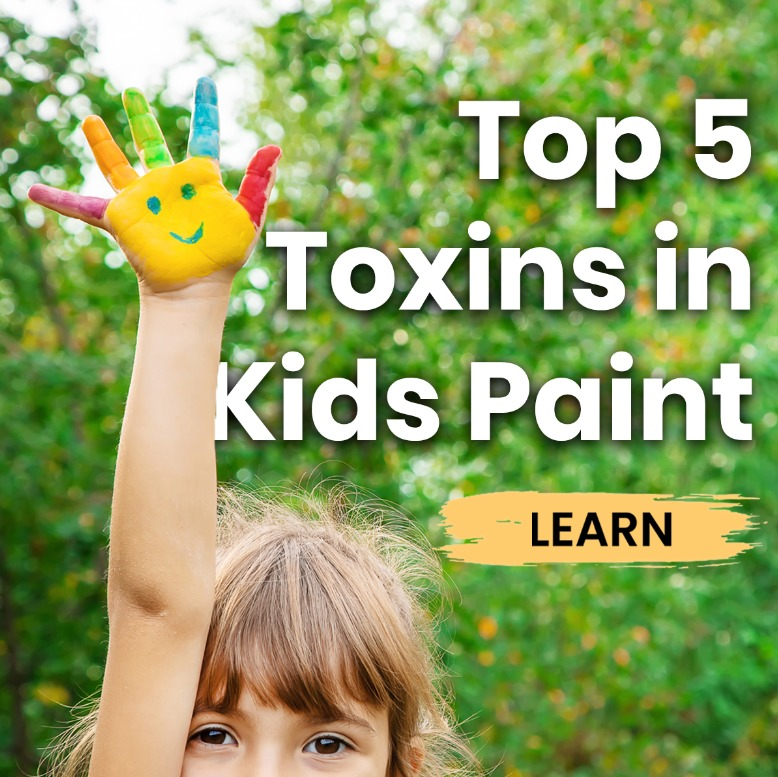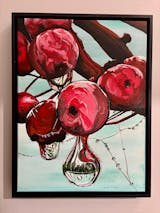As a new mom of a toddler and a health-conscious artist, I went to a local toy store in 2011 to buy my son his first paint kit. Every kit said “non-toxic” on the label but when I searched the packaging, no ingredients were listed. I decided to put on my detective hat and I called the main offices of the two most popular brands. To my surprise, they told me they could not tell me any ingredients in their products and that only a licensed physician can call poison control to find out the ingredients - IF a child has had a reaction. I also learned that there is no requirement that mandates art supplies manufacturers to tell customers the ingredients. I dove further and discovered that in the US, there is a loophole in the labeling system allowing the label “non-toxic” on supplies containing highly hazardous ingredients.

An article in Art Supplies and Poison Control by PediatricSafety.net states that, “In 2009, the nation’s 57 poison control centers received more than 35,000 calls about toxic exposures to art products; of these, more than 26,000 calls concerned children younger than 6.”
According to the Children’s Health and Environmental Coalition, exposure to the toxic chemicals found in some art supplies (including paints, glues, markers, and face paints) can result in problems including headaches; nausea; burns; breathing problems; lung and kidney damage; and even cancer and death. Children are particularly vulnerable to toxins because of their small size, higher metabolisms, and immature immune systems.

- Lead
In a study by the “Campaign for Safe Cosmetics” they reported that 10 out of 10 popular “non-toxic” kids face paints that they tested contained lead, while others also contained nickel, cobalt, and cadmium. This is something that is designed to go directly on a child’s skin (and then into their blood streams), but yet is completely unregulated. Lead is a heavy metal and potent neurotoxin that can cause developmental delays, learning difficulties, and other serious health issues in children. Most face paints also contain synthetic, petroleum-based dyes, formaldehyde-based preservatives, parabens, and phthalates.
- Synthetic Food Dyes
The most popular food dyes used in the US - Red #3 and #40, Yellow #5 and #6, and Blue #1 are banned throughout Europe and have been proven in the US to cause behavioral issues (ADHD and hyperactivity) in children. Studies in Europe have also shown these dyes to cause chromosomal damage, thyroid tumors, asthma, lymphomas, DNA damage, and more. Red #40 is the most dangerous and contains carcinogens benzidine, 4-aminobiphenyl and 4-aminoazobenzene. These dyes are used in all mainstream egg dye kits and are commonly ingested by children when they eat the eggs or enter their blood stream when their fingers dip into the dye.
- Formaldehyde
Formaldehyde is a volatile organic compound (VOC) and is the most commonly used preservative in children’s paints. It can cause respiratory problems, skin irritation, and has been classified as a known human carcinogen.
- Phthalates
Phthalates are a group of chemicals used to make plastics more flexible and are commonly found in children’s paints and acrylic paints. They can disrupt hormone systems and affect reproductive health. In the Campaign for Safe Cosmetics Study, 20% of face paints that were tested contained VOCs that caused reproductive damage including Toluene, Styrene, Ethylbenzene, and Vinyl acetate.
- Acrylic Paints
The most commonly used art/craft paint worldwide (used by children and adults) is acrylic paint. These paints are made with a petroleum-based resin, hazardous preservatives and highly toxic, carcinogenic additives and preservatives. They are harmful to children when the fumes are inhaled or if any paint gets on the skin (and then into the bloodstream). Learn more about the toxicity in acrylic paint here.

The day I discovered these shocking truths, Natural Earth Paint’s mission was cinched. I would create truly safe paints and face paints for my child and all children worldwide.
After extensive research I discovered the magical world of natural earth pigments. Proven to have been in constant use for at least the past 100,000 years, earth pigments (naturally-colored clays in the ground) make the most archival, luminous and UV resistant paints in the world – not to mention they are completely non-toxic. Throughout history they have been mixed with a variety of natural 'binders' to make different types of paint including oil, tree sap, animal fat, wax, egg yolk, milk and more.

It was surprising to me that all of these toxins in art supplies are completely unnecessary and in fact you can produce higher quality paintings with natural ingredients!

Our children’s Natural Earth Paint is made with just three ingredients: earth pigment, organic corn starch, and tree sap (gum arabic). We test our pigments based on the strictest standards for heavy metals. And we sell the paint in powder form, which you then mix with water at home, in order to avoid using toxic preservatives.
Our revolutionary Natural Acrylic Paint is the only paint in the world that looks and behaves like acrylic paint, and is made from plants. This paint frees you from the otherwise highly toxic world of acrylic paint. Read more about it here.

Our Natural Face Paint is hand-crafted in small batches with nourishing and natural ingredients - this face paint contains organic shea butter, castor seed oil, seaweed, and natural pigments - while also providing radiant, opaque, sweat resistant, water-based paint.

My son has now grown into a budding 14 year old artist and I’m so grateful that he’s had the benefit of a non-toxic start to life. And although it’s disheartening to know that most art supplies companies don’t hold our health or our planet’s health as a priority, I’m equally inspired to see more natural and non-toxic options springing up each year including fruit and veggie based art supplies.

My main advice to parents and artists today would be to read the labels or find out the ingredients of your art supplies and face paints, just as you read the labels on your food. Because when paint touches the skin or is inhaled, it goes directly into the bloodstream. And when you see 'non-toxic' on any art supplies, know that it unfortunately has no meaning anymore, and it’s up to you to be the detective in determining the best products for your child.








